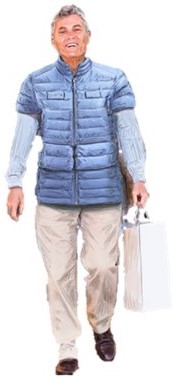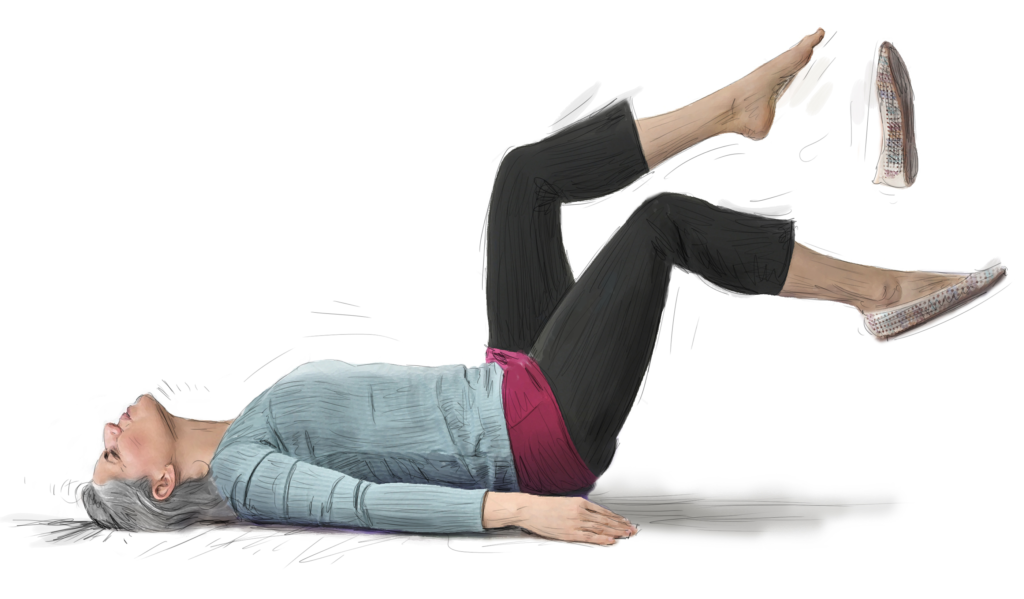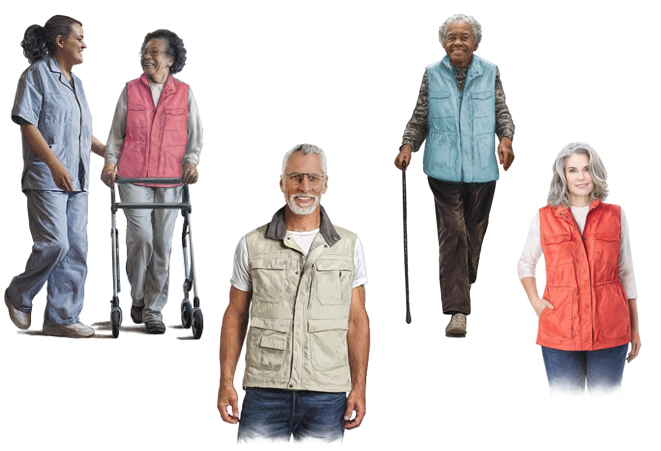MINNEAPOLIS (April 12, 2024)—We were almost ready to announce our big plan to build wearable technology to reduce terrible injuries from falls. We’d formed our business, Davenport SAF-T Systems. We filed a patent application. And we began talking to engineers. It was time to put it out there. But I had a problem. Since the build phase hadn’t started, how do I explain how it will look?
Understand, I’m a public relations professional, with years of experience in storytelling and strategic communications. This sort of thing was supposed to be my sweet spot. So how do you describe what something will look like before you build it? This felt like crystal ball stuff. I’m terrible at crystal ball stuff.
Somehow, I needed to paint a picture so people would understand this big idea about something that’s never been produced or tested. After way too much thinking, Captain Obvious figured it out. Get somebody to literally paint the picture.
That somebody was Dan O’Leary.
Meet the artist


O’Leary, of rural northern New Jersey, is a sought-after commercial artist with an impressive portfolio of work. He’s produced thousands of illustrations for clients in book publishing, magazines, advertising, package and digital media worldwide. Formally trained in a variety of mediums, O’Leary’s work appeals to a broad spectrum of art enthusiasts, from casual fans to serious collectors. His work reflects a love for the abstract, for still life, nature, and human experience.
Dan creates art with joy and purpose. I like to say I discovered Dan because of my uncanny ability to recognize rare talent. It would be more accurate to say I got to know Dan because he’s also my wife’s uncle. The fact is, Dan may be the MVP of this entire SAF-T VEST project.
At the beginning of this journey, we had my dad’s concept drawings and Styrofoam models. They helped me visualize the concept for the SAF-T VEST. But these were technical product drawings meant for engineers, researchers, and other brilliant minds. I needed people to understand what this idea could look like in its finished form. Except we didn’t really know for sure. We needed glamour shots of something in our minds known only to us. So, we got Dan on the phone. How would this look like in real life? The SAF-T VEST needed to be lightweight, breathable, and non-stigmatizing. We needed a vest that looked like, well, a vest.
Dan asked more questions. What do inflated airbags look like? Where would they be in the vest before it inflates? Can the person get back up after a fall? We reviewed sketches sent over email. More discussions. Then, I got it, he said.
The reveal
A couple of weeks later, we saw the SAF-T VEST for the first time. It felt real. He shared images of an older, but still vibrant gentleman walking through a mall with a shopping bag hanging down from one hand. There was a woman walking her dog on a lovely fall day. Both wore a collared blue vest, with visible stitching, pockets and quarter-length sleeves. It resembled a moderately puffy coat, not too thick and well-suited for indoor and outdoor use.
You wouldn’t mistake these for photographs, but they were perfect illustrations. They revealed the future of fall injury protection. There were images of airbag deployment. He provided three sequenced images of an elderly woman wearing the SAF-T VEST in a sideways fall. There’s a look of concern on her face in the first image as she loses her balance. In the 2nd image, fully inflated airbags provide a cocoon of protection around her from the hips to the head. A smile forms in the final image as she realizes she’s unhurt after the fall. Later Dan provided a 4th image—of the woman getting back up, with the airbags draped downward after fully deflating.
Dan provided illustrations of what true falls look like for older adults—violent and unforgiving. The images helped explain how different falls tend to cause different injuries, including wrist fractures, broken hips, head injuries, and elbow and shoulder trauma.

These first impressions helped make our case for fall injury protection. They even helped engineers conceptualize certain phases of development and what challenges needed to be anticipated. We used the illustrations for social media, for a planned website and for applying to accelerator programs and competitions.
As great as these illustrations were, they raised questions I didn’t expect. Questions such as:
Questions
- If that’s a puffy jacket, how would that work in the Texas or Arizona heat?
- Do you have something people could wear inside?
- Will they only come in blue?
- Could you wear this to bed at night?
- Do you have any other styles?
By giving people an idea of what the SAF-T VEST might look like, people began to ask more questions about the form than the life-saving function. I grew to anticipate these questions, reminding people that this was only one type of design, that the SAF-T VEST would come in a variety of styles and colors and thicknesses suited for indoor and outdoor use.

Illustrations by Dan O’Leary.
But my words didn’t convince anybody. The same concerns were raised—about the color, the style, and how it would work in a variety of climates. Some people asked about the motion sensor, the airbags and the onboard computer processor. But questions about look and feel dominated conversations.
Dan answered my call. We need more variety, I said. Can we make one look like it could be a fishing vest, but also worn for any occasion? How about a nighttime pajama shirt? Can we try other colors and designs? Can we have people using a cane, or a walker?
Done, done and done. Dan delivered a variety of SAF-T VEST styles, settings and applications. Now we could explain how a good-looking vest could keep people safe, independent, and active, while reducing health care costs and heartache.
Using a lot fewer words.
See more of Dan O’Leary’s work at https://www.instagram.com/danny.oleary/.
Contact Dan at dannyoleary2@gmail.com
